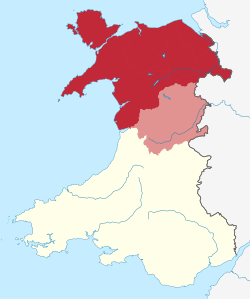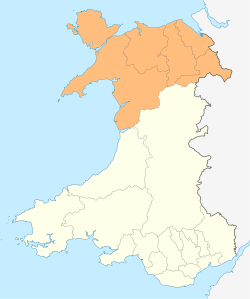
Back شمال ويلز Arabic Gogledd Cymru Welsh North Wales Danish Nordwales German Gales del Norte Spanish Põhja-Wales Estonian Iparraldeko Gales Basque Pays de Galles septentrional French Wales Utara ID Galles del nord Italian
This article needs additional citations for verification. (June 2019) |
North Wales
Gogledd Cymru North of Wales, Northern Wales, Y Gogledd | |
|---|---|
 Historical extent of North Wales (red and lighter red), Montgomeryshire (lighter red) is sometimes also considered Mid Wales. Other cultural definitions of North Wales vary. | |
 Six principal areas of Wales commonly defined to be North Wales, for policing, fire and rescue, health and regional economy. | |
| Sovereign state | |
| Constituent country | |
| Historic counties | List |
| Principal areas | List
|
| Preserved counties | |
| Localities | |
| Area | |
| • Land | 6,172 km2 (2,383 sq mi) |
| Population | |
| • Estimate (2018) [note 1] | 698,400 |
| • Density | 113.6/km2 (294/sq mi) |
| Demonym(s) | North Welsh, North Walian, "gogs" (informally) |
| Time zone | UTC±0 (GMT) |
| • Summer (DST) | UTC+1 (BST) |
| Postcode | LL, CH, SY |
North Wales (Welsh: Gogledd Cymru) is a region of Wales, encompassing its northernmost areas. It borders mid Wales to the south, England to the east, and the Irish Sea to the north and west. The area is highly mountainous and rural, with Snowdonia National Park (Parc Cenedlaethol Eryri) and the Clwydian Range and Dee Valley (Bryniau Clwyd a Dyffryn Dyfrdwy), known for its mountains, waterfalls and trails, wholly within the region. Its population is concentrated in the north-east and northern coastal areas, with significant Welsh-speaking populations in its western and rural areas. North Wales is imprecisely defined, lacking any exact definition or administrative structure.[1][2][3][note 2][4] It is commonly defined administratively as its six most northern principal areas, but other definitions exist, with Montgomeryshire historically considered to be part of the region.
Those from North Wales are sometimes referred to as "Gogs" (from "Gogledd" – the Welsh word for "north");[5] in comparison, those from South Wales are sometimes called "Hwntws" by those from North Wales.
The region includes the localities of Wrexham, Deeside, Rhyl, Colwyn Bay, Flint, Bangor, Llandudno, and Holyhead. The largest localities in North Wales are the city of Wrexham and the conurbations of Deeside and Rhyl/Prestatyn, where the main retail, cultural, educational, tourism, and transport infrastructure and services of North Wales are located. Bangor and St Asaph are the region's cities, Bangor is Wales' oldest city, whereas St Asaph is one of Wales' smallest[6] and was awarded status in 2012.[7] Wrexham, the region's largest settlement, became a city in 2022.[8]
Cite error: There are <ref group=note> tags on this page, but the references will not show without a {{reflist|group=note}} template (see the help page).
- ^ Turner, Geraint (20 May 2020). "Summary statistics for North Wales region: 2020" (PDF). gov.wales. Retrieved 6 November 2020.
- ^ "North Wales Growth Deal". Business Wales. Retrieved 2020-08-17.
- ^ "Regions of Wales". Business Wales - Wales Screen. Retrieved 2020-08-17.
- ^ Harries, Robert (2018-09-30). "Why we use different words for the same thing based on where in Wales we live". WalesOnline. Retrieved 2020-08-17.
- ^ Peter Garrett; Nikolas Coupland; Angie Williams (15 July 2003). Investigating Language Attitudes: Social Meanings of Dialect, Ethnicity and Performance. University of Wales Press. pp. 189–. ISBN 978-1-78316-207-9.
- ^ Live, North Wales (2012-03-15). "St Asaph awarded city status after beating competition from Wrexham". North Wales Live. Retrieved 2022-05-27.
- ^ "St Asaph in north Wales named Diamond Jubilee city". BBC News. 2012-03-14. Retrieved 2022-05-27.
- ^ "Official – Wrexham is now a city". Wrexham.com. Retrieved 2022-09-01.
© MMXXIII Rich X Search. We shall prevail. All rights reserved. Rich X Search